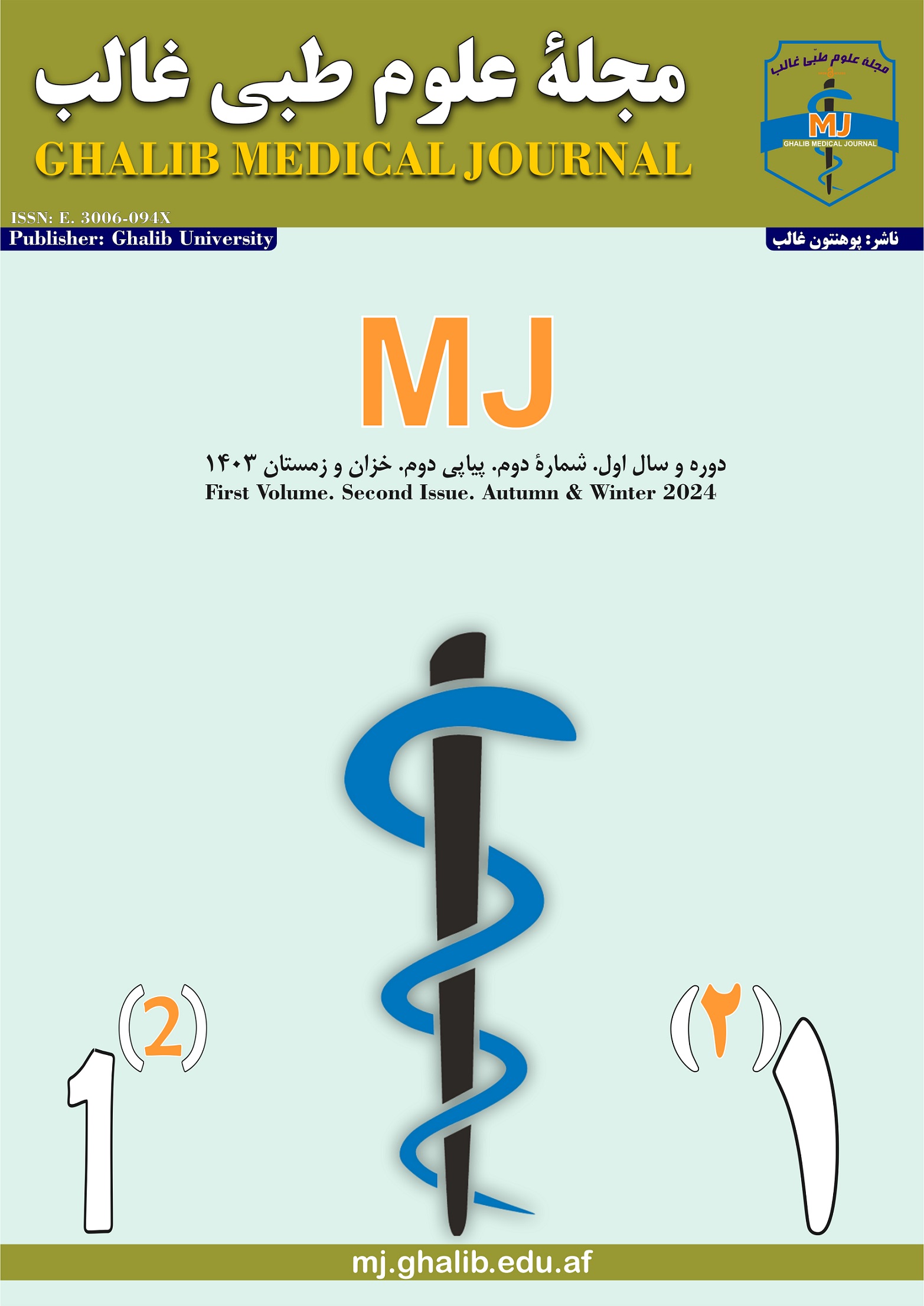Efficacy of Diclofenac in Pain and Inflammation Control Following Third Molar Surgery: A Systematic Review
DOI:
https://doi.org/10.58342/ghalibMj.V.1.I.2.3Keywords:
Diclofenac, Third Molar Surgery, Pain, Inflammation, Non-Steroidal Anti-Inflammatory Drugs, Systematic ReviewAbstract
Background: Pain and inflammation following oral surgeries are typically managed with nonsteroidal anti-inflammatory drugs (NSAIDs). The combination of opioid analgesics with NSAIDs has been shown to enhance pain management, particularly in invasive oral surgeries such as third molar extractions. This systematic review evaluates the effectiveness of diclofenac in controlling pain and inflammation after third molar surgery and compares its efficacy with other analgesic treatments. A search of Google Scholar and PubMed databases identified relevant randomized clinical trials published since 2000.
Materials and Methods: This study is a systematic review of randomized clinical trials examining the effects of diclofenac on pain control after third molar surgery. Research articles published from 2000 onwards were sourced from Google Scholar and PubMed. The review focuses on clinical trials that assessed pain levels, mouth opening, and inflammation control in patients receiving diclofenac following third molar extraction.
Results: Analysis of four studies that met the inclusion and exclusion criteria revealed that the average pain intensity at the sixth and twelfth hours post-surgery in the diclofenac group, as measured by the Visual Analog Scale (VAS), were 2.63 and 2.35, respectively. These patients experienced higher pain levels compared to the group receiving alternative analgesics (other than diclofenac) during the same time periods.
Additionally, the average mouth opening in the diclofenac group was 29 mm and 29.82 mm on the second and seventh days after surgery, respectively, compared to a preoperative average of 43 mm. Although there was some reduction in mouth opening in the diclofenac group, it was slightly lower compared to the second group, which received other analgesic medications.
Conclusion: Diclofenac demonstrated a relatively weaker analgesic effect compared to dexamethasone, ketorolac, etoricoxib, and the combination of codeine with diclofenac in managing pain following third molar surgery. However, diclofenac's analgesic efficacy was superior to tramadol. Furthermore, while diclofenac did show some effect on reducing mouth opening post-surgery, its impact was less significant compared to etoricoxib and the combination of diclofenac with codeine.
References
Marchand, S. (2008). "The physiology of pain mechanisms: from the periphery to the brain." Rheumatic disease clinics of North America 34(2): 285-309.
Świeboda, P., R. Filip, et al. (2013). "Assessment of pain: types, mechanism and treatment." Pain 2(7)
Ajmani, M., S. Jain, et al. (1986). "Age and wisdom teeth in Nigeria." Anthropologischer Anzeiger: 143-148.
Neelima, A. M. )2016(. Oral and maxillofacial Surgery. Neew Dehli; Jaypee brother’s medical publishers. P. 293-305
Dubin, A. E. and A. Patapoutian )2010(. "Nociceptors: the sensors of the pain pathway." The Journal of clinical investigation 120(11): 3760-3772.
Byers MR, Bonica JJ. Peripheral pain mechanisms and nociceptor plasticity. In: Loeser JD, editor. Management of pain. New York: Lippincott Williams & Wilkins; 2001. p. 26–72.
Meyr, A. J. and J. S. Steinberg )2008(. "The physiology of the acute pain pathway." Clinics in Podiatric medicine and surgery 25(3): 305-326.
Lamont, L. A., W. J. Tranquilli, et al. )2000(. "Physiology of pain." Veterinary Clinics: Small Animal Practice 30(4): 703-728
Meyer RA, Ringkamp M, Campbell JN, et al. Peripheral neural mechanisms of nociception. In: McMahonSB, KoltzenburgM, editors. WallandMelzack’stexbookofpain.5thedition. Philadelphia: Elsevier Limited; 2006. p. 3–34.
Renn, C. L. and S. G. Dorsey )2005(. "The physiology and processing of pain: a review." AACN Advanced Critical Care 16(3): 277-290.
Willis, W. D., E. D. Al-Chaer, et al. )۱۹۹۹(. "A visceral pain pathway in the dorsal column of the spinal cord." Proceedings of the National Academy of Sciences 96(14): 7675-7679.
Gu, Y., Tang, Y., Zhu, Q., & Feng, X. )2016(. Measurement of root surface area of per- manent teeth with root variations–A micro-CT analysis. Archives of Oral Biology, 63(3), 75–81.
Sumit, S. )2011(. A Concise text book of Oral and maxillofacial Surgery. Neew Dehli; Jaypee brother’s medical publishers. P.131-133
Balaji, S. M. )2014(. Oral and maxillofacial Surgery. Neew Dehli; Elsevier Publishers.P. 335- 345
Casy, A. F., & Parfitt, R. T. )2013(. Opioid analgesics: chemistry and receptors
Livingston, A. )2000(. Mechanism of action of nonsteroidal anti-inflammatory drugs. Veterinary Clinics: Small Animal Practice, 30(4), 773-781
Small, R. E. )1989(. "Diclofenac sodium." Clinical pharmacy 8)8(: 545-558.
Simone JL, Jorge WA, Horliana AC, Canaval TG, Tortamano IP. Comparative analysis of preemptive analgesic effect of dexamethasone and diclofenac following third molar surgery. Braz Oral Res. 2013 May-Jun;27(3):266-71. doi: 10.1590/S1806-83242013005000012. Epub 2013 Apr 19. PMID: 23657486.
Mony, D., D. Kulkarni, et al. (2016). "Comparative evaluation of preemptive analgesic effect of injected intramuscular diclofenac and ketorolac after third molar surgery-a randomized controlled trial." Journal of clinical and diagnostic research: JCDR 10(6): ZC102
Isola, G., Matarese, G., Alibrandi, A., Dalessandri, D., Migliorati, M., Pedullà, E., & Rapisarda, E. (2019). Comparison of effectiveness of etoricoxib and diclofenac on pain and perioperative sequelae after surgical avulsion of mandibular third molars: A randomized, controlled, clinical trial. The Clinical Journal of Pain, 35(11), 908-915.
Zupelari-Goncalves, P., G. Weckwerth, et al. (2017). "Efficacy of oral diclofenac with or without codeine for pain control after invasive bilateral third molar extractions." International Journal of Oral and Maxillofacial Surgery 46(5): 621-627
Clarke R, Derry S, Moore RA. Single dose oral etoricoxib for acute postoperative pain in adults. Cochrane Database Syst Rev. 2014;5:CD004309.
Prashar, D. V., Pahwa, D., Kalia, V., Jindal, G., & Kaur, R. )2016(. A comparative evaluation of the effect of diclofenac sodium with and without per-orally administered 28 methylprednisolone on the sequelae of impacted mandibular third molar removal: A cohort randomized double-blind clinical trial. Indian Journal of Dentistry, 7(1), 11.
Published
How to Cite
Issue
Section
License
Copyright (c) 2024 رحمت الله نظری, هدایت الله احسان, اسدالله دانشیار

This work is licensed under a Creative Commons Attribution 4.0 International License.










